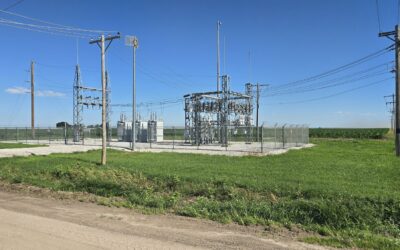
Gwen Kautz
General Manager
For over 100 years, electric companies have given people and businesses reliable power. Because of this, we’ve all gotten completely used to electricity always being there when we need it – the lights staying on and appliances and electronics working nonstop. We take it for granted that flipping a switch or plugging in something guarantees instant power.
Traditional power plants like nuclear, coal and natural gas are good at matching the amount of electricity being made to the amount being used by everyone’s homes, businesses, schools and farms. They can easily turn up or down how much electricity they make to meet consumer demand. Nuclear cannot “easily” ramp up or down.
But now, more renewable energy sources like solar panels and wind turbines are being added to generate electricity. And these create a big problem for keeping the lights on reliably. The reliable, constant power we’ve had for decades could become a thing of the past without backup power sources in place.
The issue is that solar and wind are not predictable – they make electricity only when the sun is shining or the wind is blowing. As soon as a cloud covers a solar farm or the wind dies down, those sources stop making power. Unlike a natural gas power plant that can just burn more gas, there’s no controlling nature.
Let’s consider how the abrupt disruption could cost companies thousands of dollars because server rooms, telecommunications infrastructure and manufacturing lines full of computerized machinery are incredibly sensitive to power changes. Dropout events can corrupt data, crash programs and processes, and often require lengthy restart procedures to recover operations. On a personal note, losing electricity may simply mean my wireless router stops, but that’s ok, the computer isn’t running anyway, and my phone has LTE unless the communication provider is affected. Who’s to know?
To prevent those interruptions and keep power 100% reliable with renewable energy, electric utilities would need/require backup power plants (running on fossil fuels) or large-scale batteries ready to pick up the shortfall instantly and seamlessly whenever the renewables stop working. But having that redundant power supply infrastructure running duplicates alongside the renewable plants is extremely expensive. There are additional maintenance problems with ramping power plants up and down based on simple demand caused by the lack of sun or wind.
So, we’re faced with a choice – put up with some potential power disruptions as more renewable energy comes online and hope our sensitive electronic devices have safeguards built in, or agree to pay a lot more, possibly double, so backup power plants can be built to maintain absolute reliable service no matter what’s happening with the solar/wind.
For over a century we’re gotten used to just flipping a switch and having power all the time. But bringing more renewable energy into the mix means customers and electric companies may have to reset their expectations around reliability versus cost. It’s a big challenge to figure out going forward.
If we can’t count on having a continuous supply of electricity from the grid, one would need to consider (personal) back up power sources. This could include on-site generators (requiring stored fuel), battery banks or renewable sources like solar panels coupled with battery storage. These choices add cost to renewable energy.
Essentially, weaning off total dependency on our current reliable power grid would require decentralized, locally sourced power combined with enhanced microgrid capabilities and robust emergency preparedness. That means all of us must adjust our “reliable power” expectations.
We understand private renewable choices and do our best to be your partner. When a customer installs solar, Dawson PPD becomes that instant back up option when the sun doesn’t shine. We want to help customers make good decisions. Personally, I think being able to flip a switch, plug in a charger and not worry about reliability and affordability is my chosen path. Traditional power plants offer that peace of mind.
OTHER NEWS
Dawson PPD plans substation work
Two rural Dawson Public Power District substations will be getting upgrades after the 2024 irrigation season. Sub 26, located southwest of Gothenburg, will be upgraded as part of a voltage conversion. Sub 35, located northeast of Gothenburg, is being improved to...
Dawson PPD’s board considers contract, load growth
Dawson Public Power District’s regular board meeting was held on July 3, 2024. Darin Bloomquist, General Manager of the Nebraska Electric Generation & Transmission Cooperative, gave an update on the organization’s work....
A day in the life of a consumer accounting representative
Have you ever wondered what happens behind the scenes when you call or visit Dawson PPD headquarters? Consumer Accounting Representatives (CARs) wear many hats, juggling multiple tasks throughout the day to keep things running smoothly.


